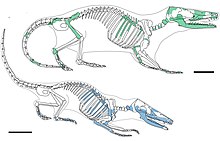| Docodonts Temporal range: Middle Jurassic-Early Cretaceous
| |
|---|---|

| |
| Skeletal diagrams of Borealestes serendipitus (green) and B. cuillinensis (blue) Scale bars = 10 mm | |
| Scientific classification | |
| Domain: | Eukaryota |
| Kingdom: | Animalia |
| Phylum: | Chordata |
| Clade: | Synapsida |
| Clade: | Therapsida |
| Clade: | Cynodontia |
| Clade: | Mammaliaformes |
| Order: | †Docodonta Kretzoi, 1946 |
| Genera | |
|
See text. | |
Docodonta is an order of extinct Mesozoic mammaliaforms (advanced cynodonts closely related to true crown-group mammals). They were among the most common mammaliaforms of their time, persisting from the Middle Jurassic to the Early Cretaceous across the continent of Laurasia (modern-day North America, Europe, and Asia). They are distinguished from other early mammaliaforms by their relatively complex molar teeth. Docodont teeth have been described as "pseudotribosphenic": a cusp on the inner half of the upper molar grinds into a basin on the front half of the lower molar, like a mortar-and-pestle. This is a case of convergent evolution with the tribosphenic teeth of therian mammals. There is much uncertainty for how docodont teeth developed from their simpler ancestors. Their closest relatives may have been certain Triassic "symmetrodonts", namely Woutersia, and Delsatia.[1] The shuotheriids, another group of Jurassic mammaliaforms, also shared some dental characteristics with docodonts. One study has suggested that shuotheriids are closely related to docodonts,[2] though others consider shuotheriids to be true mammals, perhaps related to monotremes.[3]
For much of their history of study, docodont fossils were represented by isolated teeth and jaws. The first docodont known from decent remains was Haldanodon, from the Late Jurassic Guimarota site of Portugal. Recently, exceptionally preserved skeletons have been discovered in the Jurassic Tiaojishan Formation of China. Chinese docodonts include otter-like,[4] mole-like,[5] and squirrel-like species,[6][7] hinting at impressive ecological diversity within the group. Many docodonts have muscular limbs and broad tail vertebrae, adaptations for burrowing or swimming. Like true mammals, docodonts have hair,[4] a saddle-shaped hyoid apparatus,[7] and reduced postdentary jaw bones which are beginning to develop into middle ear ossicles. On the other hand, the postdentary bones are still attached to the jaw and skull, the nares (bony nostril rims) have yet to fuse, and in most species the spine's thoracic-lumbar transition is rather subdued.[5][6]
- ^ Luo, Zhe-Xi; Martin, Thomas (2007). "Analysis of Molar Structure and Phylogeny of Docodont Genera". Bulletin of Carnegie Museum of Natural History. 2007 (39): 27–47. doi:10.2992/0145-9058(2007)39[27:AOMSAP]2.0.CO;2. ISSN 0145-9058. S2CID 29846648.
- ^ Mao, Fangyuan; Li, Zhiyu; Wang, Zhili; Zhang, Chi; Rich, Thomas; Vickers-Rich, Patricia; Meng, Jin (2024-04-03). "Jurassic shuotheriids show earliest dental diversification of mammaliaforms". Nature. doi:10.1038/s41586-024-07258-7. ISSN 0028-0836.
- ^ Cite error: The named reference
:14was invoked but never defined (see the help page). - ^ a b Cite error: The named reference
:3was invoked but never defined (see the help page). - ^ a b Luo, Zhe-Xi; Meng, Qing-Jin; Ji, Qiang; Liu, Di; Zhang, Yu-Guang; Neander, April I. (2015-02-13). "Evolutionary development in basal mammaliaforms as revealed by a docodontan". Science. 347 (6223): 760–764. Bibcode:2015Sci...347..760L. doi:10.1126/science.1260880. PMID 25678660. S2CID 206562572.
- ^ a b Meng, Qing-Jin; Ji, Qiang; Zhang, Yu-Guang; Liu, Di; Grossnickle, David M.; Luo, Zhe-Xi (2015-02-13). "An arboreal docodont from the Jurassic and mammaliaform ecological diversification". Science. 347 (6223): 764–768. Bibcode:2015Sci...347..764M. doi:10.1126/science.1260879. PMID 25678661. S2CID 206562565.
- ^ a b Cite error: The named reference
:10was invoked but never defined (see the help page).